Improved Fitness-Dependent Optimizer for Solving Economic Load Dispatch Problem
- PMID: 35860638
- PMCID: PMC9293509
- DOI: 10.1155/2022/7055910
Improved Fitness-Dependent Optimizer for Solving Economic Load Dispatch Problem
Abstract
Economic load dispatch depicts a fundamental role in the operation of power systems, as it decreases the environmental load, minimizes the operating cost, and preserves energy resources. The optimal solution to economic load dispatch problems and various constraints can be obtained by evolving several evolutionary and swarm-based algorithms. The major drawback to swarm-based algorithms is premature convergence towards an optimal solution. Fitness-dependent optimizer is a novel optimization algorithm stimulated by the decision-making and reproductive process of bee swarming. Fitness-dependent optimizer (FDO) examines the search spaces based on the searching approach of particle swarm optimization. To calculate the pace, the fitness function is utilized to generate weights that direct the search agents in the phases of exploitation and exploration. In this research, the authors have used a fitness-dependent optimizer to solve the economic load dispatch problem by reducing fuel cost, emission allocation, and transmission loss. Moreover, the authors have enhanced a novel variant of the fitness-dependent optimizer, which incorporates novel population initialization techniques and dynamically employed sine maps to select the weight factor for the fitness-dependent optimizer. The enhanced population initialization approach incorporates a quasi-random Sabol sequence to generate the initial solution in the multidimensional search space. A standard 24-unit system is employed for experimental evaluation with different power demands. The empirical results obtained using the enhanced variant of the fitness-dependent optimizer demonstrate superior performance in terms of low transmission loss, low fuel cost, and low emission allocation compared to the conventional fitness-dependent optimizer. The experimental study obtained 7.94E-12, the lowest transmission loss using the enhanced fitness-dependent optimizer. Correspondingly, various standard estimations are used to prove the stability of the fitness-dependent optimizer in phases of exploitation and exploration.
Copyright © 2022 Barzan Hussein Tahir et al.
Conflict of interest statement
The authors declare that they have no conflicts of interest.
Figures










References
-
- Sale T. Alan Turing: Life and Legacy of a Great Thinker . Berlin, Germany: Springer; 2004. Alan turing at bletchley park in world war II; pp. 441–462.
-
- Wang G. G., Deb S., Coelho L. D. S. Earthworm optimisation algorithm: a bio-inspired metaheuristic algorithm for global optimisation problems. International Journal of Bio-Inspired Computation . 2018;12(1):p. 1. doi: 10.1504/ijbic.2018.093328. - DOI
-
- Sheta A., Faris H., Braik M., Mirjalili S. Applied Nature-Inspired Computing: Algorithms and Case Studies . Singapore: Springer; 2019. Nature-Inspired Metaheuristics Search Algorithms for Solving the Economic Load Dispatch Problem of Power System: A Comparison Study; pp. 199–230. - DOI
-
- Ahmadianfar I., Shirvani-Hosseini S., Samadi-Koucheksaraee A., Yaseen Z. M. Surface water sodium (Na+) concentration prediction using hybrid weighted exponential regression model with gradient-based optimization. Environmental Science and Pollution Research International . 2022:1–26. doi: 10.1007/s11356-022-19300-0. - DOI - PubMed
Publication types
MeSH terms
LinkOut - more resources
Full Text Sources

